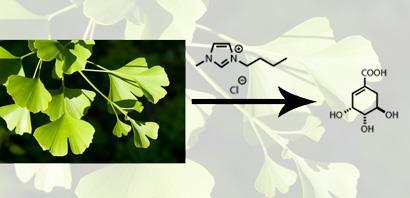Isolating Tamiflu starting material from Ginkgo biloba trees could avoid future Tamiflu shortages
Japanese scientists have discovered a new way of obtaining shikimic acid, the compound needed to make the influenza drug Tamiflu. They found that the acid could be extracted and isolated from the leaves of the Ginkgo biloba tree using an ionic liquid.
Tamiflu (oseltamir phosphate) hit the headlines in 2005 for its effectiveness against H5N1, a strain of the influenza virus known as bird flu. Tamiflu inhibits neuraminidase - an enzyme that enables the virus to be released from the host cell - and prevents the virus from reproducing.
Oseltamir phosphate is synthesised via a multistep process developed by pharmaceutical company Roche, and uses shikimic acid as the starting material. Shikimic acid is normally obtained from star anise, a Chinese cooking spice. But the shortage of star anise caused Roche problems a few years ago, when the demand for Tamiflu peaked during the H1N1 - swine flu - pandemic in 2009, so new sources are being sought.

Toyonobu Usuki, from Sophia University, Tokyo, extracted shikimic acid by stirring Ginkgo biloba leaves at 150 degrees Celsius in an ionic liquid. The ionic liquid dissolved the cellulose, which allowed the shikimic acid to be separated and isolated. Ginkgo biloba is mainly found in China and has a long history in Chinese medicine.
Shikimic acid has been obtained from other plants and been made by genetically modified bacteria, but these methods have not given as high a yield as Usuki’s method. ’Since the yield from gingko is quite close to the one from star anise, the gingko leaves are an interesting raw material,’ says Volkmar Jordan, an expert in obtaining natural substances from plants at M?nster University of Applied Sciences, Germany.
Usuki hopes that his technique will be used commercially. ’The technique is quite simple, but the problem is the cost of building the plants for the extraction-isolation part,’ he says. Jordan adds: ’The processing of the used ionic liquid and of the raw material residues must be developed before the technique can be applied in industrial scale processes.’
Usuki plans to isolate other natural products from Ginkgo biloba, including terpene trilactones, which may have potential uses in improving blood circulation, the treatment of Alzheimer’s, and have been linked to improved memory.
Holly Sheahan
Link to journal article
Extraction and isolation of shikimic acid from Ginkgo biloba leaves utilizing an ionic liquid that dissolves celluloseToyonobu Usuki, Nanae Yasuda, Masahiro Yoshizawa-Fujita and Masahiro Rikukawa,?Chem. Commun., 2011, 47, 10560DOI:10.1039/c1cc13306c






No comments yet